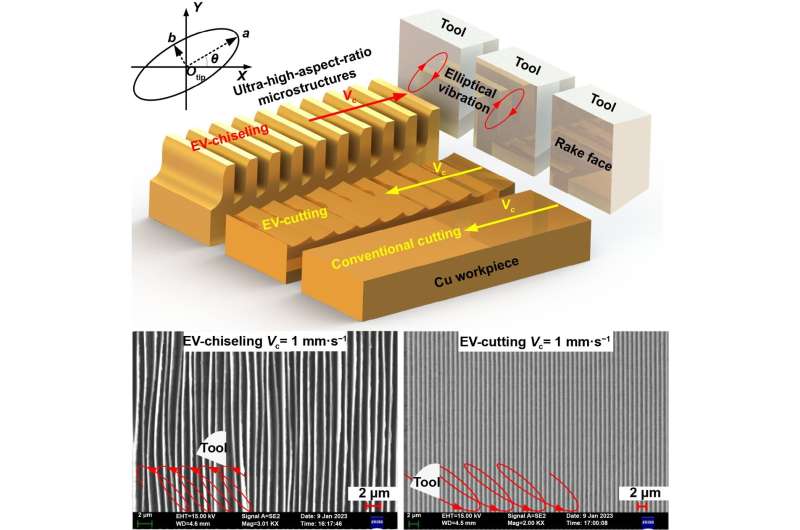
Compared with other cutting methods, EV-chiseling could generate metallic microstructures with ultra-high aspect ratio, and the cutting chip could be directly transformed into unique microstructures.
Scientists from Tsinghua University have proposed a novel process to convert the cutting chips into microstructures directly and make the chips useful. The research is published in the International Journal of Extreme Manufacturing.
This upends the conventional wisdom about manufacturing cutting chips usually turned into waste after processing. The finding is unexpected and interesting, it's hard to imagine how many chips are disposed of as waste every day; if using our process, the waste could be turned into treasures.
"In principle, this proposed method is the original innovation in the field of processing, and provides a new way of fabricating metallic microstructures," said Jianjian Wang, an associate professor of the Department of mechanical engineering at the Tsinghua University and corresponding author on the study.
"In general, this method links the waste-cutting chips and useful metallic microstructures," said Zhiwei Li (Ph.D. student, now at Tsinghua), the first author of the paper.
Microstructures are everywhere if you look carefully at the surface of objects, whether it is the surface of plants (lotus leaves, roses, straw, etc.), or the surface of animal hair, or human skin.
It has been found that such microstructures have special properties such as hydrophilicity, hydrophobicity and antibacterial properties, but so far, it is still a difficult problem to fabricate such microstructures on metal surfaces, and the key is to increase the aspect ratio (height divides width). This is because metal materials are not easy to work with, especially on small scales.
Cutting is the most commonly used machining method for metal materials. Then Li began experimenting with different cutting methods two years ago, but always failed, "I tried almost every machining method, but the aspect ratio could not be increased," said Li. One day during a discussion, Wang said, "If we change the feeding direction, would there be a difference?"
"That [could] maybe work, especially changing the feeding direction of elliptical vibration cutting," said Li. However, the initial experiments were not ideal.
"We believe that changing feeding direction must be useful," said Wang, then they re-designed the processing device and optimized the shooting method, and satisfactory results were finally obtained.
"It is amazing that the chip is completely invisible during the cutting process, and the chip could be found directly into the microstructure through SEM," said Li. They found that by changing the processing parameters different kinds of microstructures could be transformed directly through the chips.
"We are using the processed microstructures to carry out a large number of application experiments, including enhanced heat transfer, anti-icing, antibacterial, etc., and have achieved relatively good experimental results, which can be more widely used in the future," said Wang.
Wang and his lab are working with other scientists around the university to try to understand how the microstructures generate. "There are many problems that need to be further solved, such as the mechanical mechanism of chip transformation and the change of surface structure, which are related to future applications," said Wang.
More information: Zhiwei Li et al, Elliptical vibration chiseling: a novel process for texturing ultra-high-aspect-ratio microstructures on the metallic surface, International Journal of Extreme Manufacturing (2024). DOI: 10.1088/2631-7990/ad1bbb
Provided by International Journal of Extreme Manufacturing
Citation: How to make chips produced in the cutting process useful (2024, March 28) retrieved 28 March 2024 from https://techxplore.com/news/2024-03-chips.html
This document is subject to copyright. Apart from any fair dealing for the purpose of private study or research, no part may be reproduced without the written permission. The content is provided for information purposes only.
